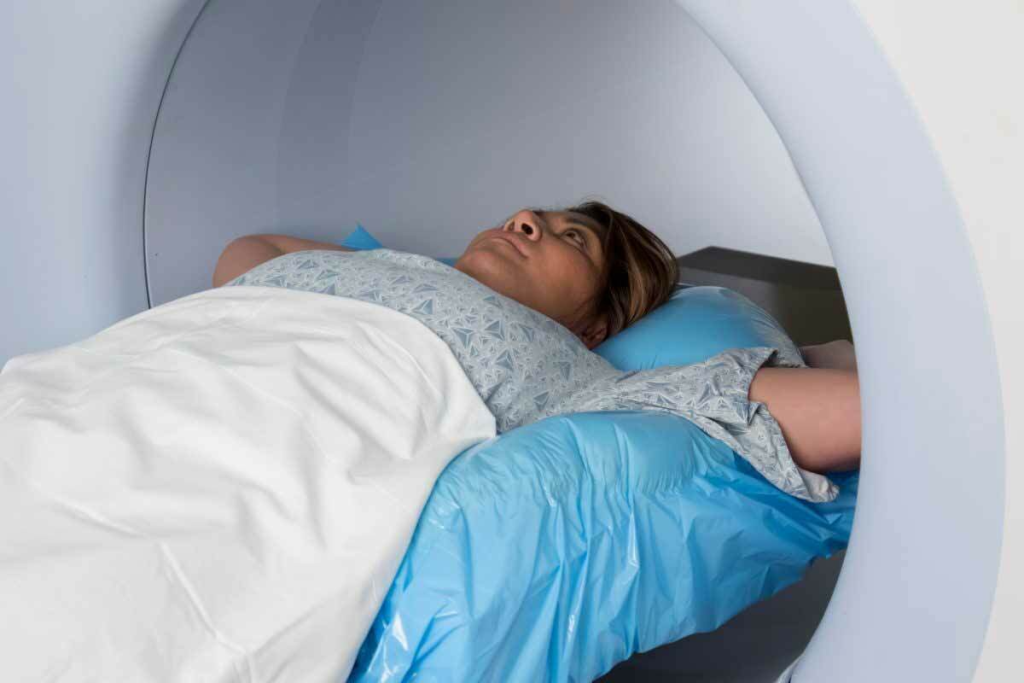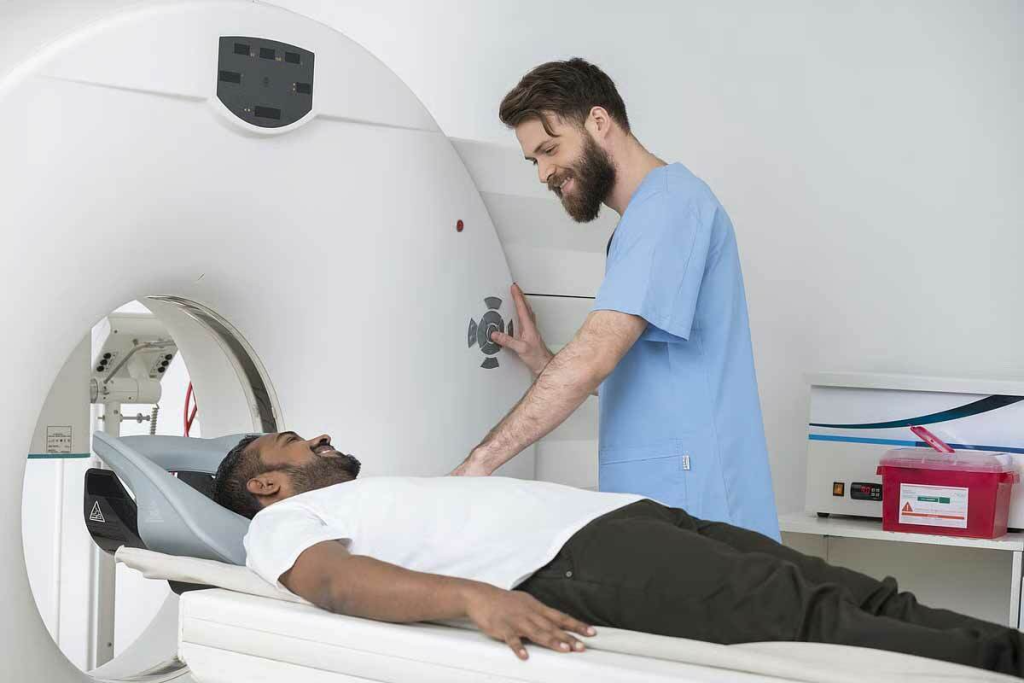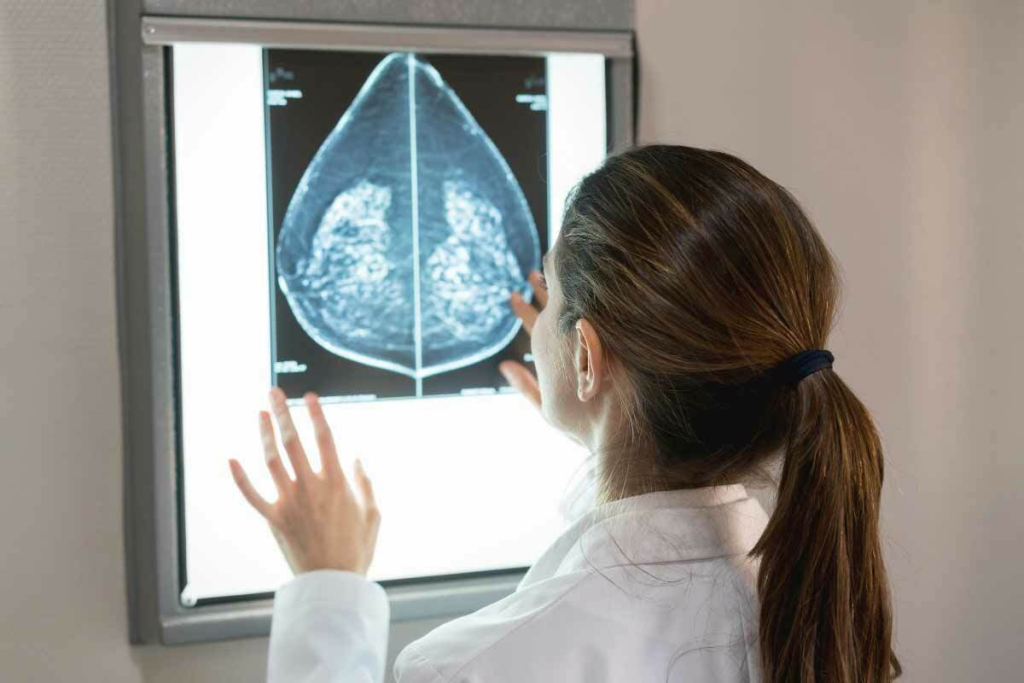
Cancer detection has become more advanced with new scanning technologies. So, what scan shows cancer? Various imaging scans, including CT scans, MRI, PET scans, and X-rays, are used to detect cancer at early sDoes a PET Scan for Cancer Staging Show the Stage of Cancer?tages. CT and MRI scans provide detailed images of internal organs and tissues to spot tumors, while PET scans highlight areas of increased metabolic activity often seen in cancer cells. Early detection through these scans is key to better treatment and survival rates, enabling timely and targeted interventions.
Many scans are crucial for detecting, staging, and monitoring cancer. CT scans, MRI, PET scans, and PET/CT are among the best. These scans for cancer detection help doctors diagnose and treat cancer better.
It’s important to know about the different scans and their uses. This article will look at the top scans for cancer detection. We’ll talk about their benefits and how they compare in speed and accuracy.

Cancer imaging technologies are very important. They help find cancer early. Early detection is key to treating cancer effectively.
These technologies have changed how we fight cancer. They help find and stage cancer early and accurately.
Finding cancer early is very important. It means treatments work better. This increases the chance of surviving.
A multi-cancer early detection test can spot cancer before symptoms show. This could save lives.
The benefits of early detection include:
Imaging methods detect cancer in different ways. For example:
Knowing how these technologies work is key. It helps doctors make accurate diagnoses and treatment plans.

CT scans are key in cancer detection because they give detailed images quickly. They are essential for spotting tumors and figuring out their size and where they are.
CT scans use X-rays to make detailed pictures of the body. An X-ray machine moves around the body to take images from different sides. These images are then put together to make a complete picture. This detailed image helps find tumors and understand their size and location.
CT scans are great for finding cancers in the lungs, liver, and pancreas. They give clear pictures of these areas. This makes them a key tool in diagnosing and understanding cancer.
CT scans are fast and easy to get. They usually take just a few minutes and are found in many hospitals. This makes them a top choice for many patients, even in urgent cases or when quick diagnosis is needed.
| Cancer Type | Detection Method | Advantages |
| Lung Cancer | CT Scan | Identifies small tumors |
| Liver Cancer | CT Scan | Assesses tumor impact |
| Pancreatic Cancer | CT Scan | Determines tumor size and spread |
MRI is top-notch for seeing soft tissues inside the body. It does this without using harmful radiation. This makes MRI great for finding cancers in soft tissues.
MRI uses a strong magnetic field and radio waves to show body details. It aligns hydrogen nuclei with a magnetic field and then uses radio waves to disturb them. This creates signals for detailed images.
MRI can tell soft tissues apart. This is key for spotting tumors and seeing how big they are. It’s very useful for tricky body parts.
MRI shines in finding cancers in the brain, spine, and prostate. It gives clear pictures of these areas. This helps doctors catch cancers early and plan treatments.
MRI has big pluses like no radiation and clear soft tissue images. But, it’s pricier and not as common as CT scans.
| Advantages | Limitations |
| No ionizing radiation | Higher costs |
| High-resolution soft tissue imaging | Less availability |
| Effective for brain, spine, and prostate cancers | Claustrophobia issues for some patients |
In short, MRI is a key tool for finding cancers, mainly in soft tissues. Its benefits make it vital for cancer diagnosis, even with some downsides.
PET scans give us a special look at how cancer cells work. They change how we find and treat cancer. Unlike other tests, PET scans show what’s happening inside the body, not just what it looks like.
PET scans use a special sugar that cancer cells love. This sugar, called Fluorodeoxyglucose (FDG), helps find cancer. Cancer cells use more of it than healthy cells, making them easy to spot.
First, the patient gets the sugar tracer through an injection. Then, they wait for it to spread in their body. The PET scanner picks up the sugar’s glow, showing where cancer is.
PET scans are great for finding many types of cancer. They work well for lymphoma, melanoma, and cancers of the lung, breast, and colon. They’re also good at finding cancer that has spread.
They help doctors see if treatments are working. By watching how tumors change, doctors can make treatment plans better.
PET scans are very accurate, even better when used with CT scans. Combining PET and CT scans (PET/CT) gives doctors a complete picture. This helps in finding and understanding cancer better.
But, PET scans have downsides. They use some radiation, and they can be expensive. Sometimes, they might show false positives, like when inflammation looks like cancer.
Even with these challenges, PET scans are a key tool in fighting cancer. They help doctors make better choices and improve patient care.
PET/CT hybrid imaging has changed how we diagnose cancer. It combines PET scans’ metabolic info with CT scans’ detailed images. This gives a full view of the cancer’s size and where it is.
PET and CT scans together offer a clearer picture of cancer than each alone. “PET/CT has become a key tool in fighting cancer,” a study says. PET scans show where cancer is active, while CT scans show exactly where it is.
This mix of scans helps doctors stage cancer better. It helps find the main tumor, spot cancer spread, and check how treatments work.
PET/CT hybrid imaging boosts how well we can diagnose cancer in many ways:
By mixing functional and anatomical info, PET/CT gives a full view of the disease. This helps doctors make better treatment plans.
PET/CT is top choice for many cancers because it’s very accurate in staging and checking cancer. This hybrid imaging is a comprehensive diagnostic solution that’s key for complex cases.
Experts say, “Combining PET and CT has greatly improved how we diagnose and care for cancer patients.” This is because PET/CT can spot cancer more accurately than other scans. It’s a vital tool in cancer diagnosis.
Ultrasound is key in finding cancer early. It’s a non-invasive way to see inside the body. High-frequency sound waves create detailed images, helping in cancer screening.
Ultrasound uses sound waves to make images of organs and tissues. Doctors can spot tumors and abnormalities. How well it works depends on the operator’s skill and the equipment’s quality.
Key aspects of ultrasound in cancer detection include:
Ultrasound is used for many cancers, like:
It’s very good at finding these cancers, making it a key tool in fighting cancer.
Ultrasound is safe because it doesn’t use radiation. It’s also not very expensive. But it has some downsides. It needs skilled operators and can’t see very deep.
Even with its limits, ultrasound is a great tool against cancer. It’s safe and easy to get, helping find cancer early.
Mammography is a key tool in finding breast cancer early. It gives detailed images that help doctors spot cancer quickly. Women should start getting mammograms at 40, and keep getting them regularly to catch cancer early.
Over time, mammography has changed. The old 2D mammography was common for years. But now, 3D mammography, or tomosynthesis, is better at finding cancer. It shows more detail in the breast tissue, which means fewer false alarms and better cancer detection.
The benefits of 3D mammography include:
Mammography is very good at finding breast cancer early. This can lead to:
Regular screening is key. It catches cancer before symptoms show, which is a big help in fighting breast cancer.
Health groups have set rules for mammograms. Most say women should start at 40. But, if you have a family history or other risk factors, you might need to start sooner or get checked more often.
It’s important to talk to your doctor. They can help figure out the best schedule for you, based on your risk and health history.
The world of cancer detection is changing fast with new technologies. These new tools could change how we find and treat cancer. They might help us catch cancer early and make treatments more effective.
Liquid biopsies are a big step forward in finding cancer. They look for cancer DNA in the blood. Blood-based testing is easy and can be done many times to track cancer.
Studies show liquid biopsies work well for finding cancers like lung, breast, and colon. They can spot cancer-specific DNA, helping find cancer early.
Whole-body imaging, like total body PET scans, can find cancer anywhere in the body. It gives a full picture of cancer spread. This helps doctors plan treatments better.
Whole-body imaging is great because it can find many cancers at once. This is very useful for people at high risk of getting different cancers.
| Imaging Technique | Cancer Types Detected | Advantages |
| Total Body PET | Various, including lymphoma, melanoma | Comprehensive whole-body assessment |
| Liquid Biopsy | Lung, breast, colorectal cancer | Minimally invasive, early detection possible |
Artificial intelligence (AI) is being used more in cancer detection. AI looks at complex data to find patterns that humans might miss.
AI is getting better at making cancer diagnoses, like from mammograms and CT scans. It can make diagnoses more accurate. This means fewer mistakes and better treatments.
These new technologies are changing cancer detection and treatment. They could lead to earlier and more accurate diagnoses. This could save lives and improve patient care.
When it comes to finding cancer, how fast and accurate a test is matters a lot. Different tests have different balances of speed and accuracy. It’s important to know what each test is good at and what it’s not.
The time it takes to find cancer with different scans varies a lot. For example, CT scans are fast, taking just a few minutes. On the other hand, MRI scans can take longer, sometimes up to an hour, because they do detailed imaging.
Speed is important, but how accurate a test is is even more so. Different scans are better at finding different types of cancer.
| Scan Type | Accuracy Rate for Cancer Detection |
| CT Scan | High accuracy for detecting tumors in organs like the liver and lungs. |
| MRI | Excellent for soft tissue cancers, such as brain and spinal tumors. |
| PET/CT | Highly accurate for detecting metabolically active cancer cells. |
| Ultrasound | Effective for superficial organs like the thyroid and breast. |
Choosing the right test means finding a balance between speed and accuracy. PET/CT hybrid imaging is often the best because it shows both metabolic activity and anatomy, making it fast and accurate.
In conclusion, each scan has its own strengths and weaknesses. Knowing what you need and what the cancer is like helps pick the best test.
Choosing the right cancer detection method is important. It depends on the type of cancer and the patient’s health. Healthcare providers look at many factors to pick the best test.
Each cancer detection method has its own strengths and weaknesses. CT scans show detailed cross-sections, while MRI is great for soft tissue. PET/CT combines both, making it a top choice for cancer diagnosis. Knowing these options helps patients and doctors make the best choice.
Early detection is key to treating cancer well. The right imaging test can lead to quick and effective treatment. The goal is to find a balance between speed and accuracy for the best diagnosis and treatment plan.
The best scan for cancer depends on the type of cancer. CT scans are often used first. But, PET/CT is the top choice for many cancers because it’s very accurate.
CT scans are quick and good for first checks. But, how fast you find cancer also depends on the cancer type and the technology used.
Many scans help find cancer, like CT scans, MRI, PET scans, and ultrasound. Each is best for different cancers.
A PET/CT scan mixes PET’s metabolic info with CT’s detailed images. This gives a full picture of the cancer’s size and where it is.
MRI is great for finding cancers in the brain, spine, and prostate. It’s good because it shows soft tissues well and doesn’t use harmful radiation.
Yes, new tech includes liquid biopsies, blood tests, and whole-body PET scans. Artificial intelligence (AI) is also being used to make diagnoses better and faster.
Mammography, like 3D mammography, is very good at finding breast cancer early. It’s recommended for women to start screening at 40.
Ultrasound is great for screening because it’s non-invasive and easy to get. It’s often used for thyroid, breast, and prostate cancer checks.
Choosing an imaging test depends on the cancer type, the patient’s health, and what each test can do well.
Subscribe to our e-newsletter to stay informed about the latest innovations in the world of health and exclusive offers!
WhatsApp us